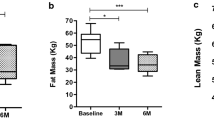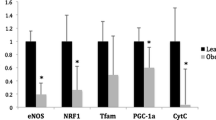Abstract
Purpose
White adipose tissue (WAT) browning plays a crucial role in energy metabolism. However, it remains unclear whether WAT browning is involved in the adipose reduction following sleeve gastrectomy (SG). Adiponectin is upregulated after Roux-en-Y gastric bypass surgery. The role of adiponectin in SG was further investigated in the current study.
Materials and Methods
Diabetic Sprague Dawley rats were randomly divided into control, sham + libitum, sham + food restriction, and sleeve groups. Browning markers, including uncoupling protein 1 (UCP1), peroxisome proliferator-activated receptor (PPAR) γ, and PPARγ coactivator-1 alpha (PGC-1α), were examined 4 weeks after the operation.
Results
UCP1, PPARγ, and PGC-1α expression were significantly higher in the sleeve group compared to the other study groups. The adipose tissue of the sleeve group exhibited tissue weight loss and additional morphological browning features. In addition, adiponectin expression in the sleeve group was significantly increased. Adiponectin upregulated the expression of the browning genes and sirtuin 1 (SIRT1) in 3T3-L1 adipocytes. SIRT1 could increase the WAT browning levels, revealing that adiponectin induced the browning process via the upregulation of SIRT1. Furthermore, SIRT1 represented a positive regulatory feedback loop for adiponectin. SIRT1 activated adenosine monophosphate-activated protein kinase (AMPK), which can mediate WAT browning. Inhibition of the AMPK signaling pathway by dorsomorphin decreased UCP1, PPARγ, and PGC-1α expression. However, additional studies are needed to understand the relationship between adiponectin and glucose homeostasis.
Conclusions
Sleeve gastrectomy increased adiponectin levels, which in turn upregulated SIRT1. Thus, SIRT1 may function as an endocrine signal to mediate WAT browning.





Similar content being viewed by others
References
Picon-Ruiz M, Morata-Tarifa C, Valle-Goffin JJ, et al. Obesity and adverse breast cancer risk and outcome: mechanistic insights and strategies for intervention. CA Cancer J Clin. 2017;67(5):378–97.
Lackey DE, Olefsky JM. Regulation of metabolism by the innate immune system. Nat Rev Endocrinol. 2016;12(1):15–28.
Jia G, Jia Y, Sowers JR. Contribution of maladaptive adipose tissue expansion to development of cardiovascular disease. Compr Physiol. 2016;7(1):253–62.
Giles ED, Wellberg EA, Astling DP, et al. Obesity and overfeeding affecting both tumor and systemic metabolism activates the progesterone receptor to contribute to postmenopausal breast cancer. Cancer Res. 2012;72(24):6490–501.
Bray GA, Fruhbeck G, Ryan DH, et al. Management of obesity. Lancet. 2016;387(10031):1947–56.
Puzziferri N, Roshek 3rd TB, Mayo HG, et al. Long-term follow-up after bariatric surgery: a systematic review. JAMA. 2014;312(9):934–42.
Sjostrom L. Review of the key results from the Swedish Obese Subjects (SOS) trial—a prospective controlled intervention study of bariatric surgery. J Intern Med. 2013;273(3):219–34.
He B, Chen L, Yu C, et al. Roux-en-Y gastric bypass increases hepatic and peripheral insulin sensitivity in rats with type 2 diabetes mellitus. Surg Obes Relat Dis. 2014;10(3):485–93.
Bojsen-Moller KN, Dirksen C, Jorgensen NB, et al. Early enhancements of hepatic and later of peripheral insulin sensitivity combined with increased postprandial insulin secretion contribute to improved glycemic control after Roux-en-Y gastric bypass. Diabetes. 2014;63(5):1725–37.
He B, Piao D, Yu C, et al. Amelioration in hepatic insulin sensitivity by reduced hepatic lipid accumulation at short-term after Roux-en-Y gastric bypass surgery in type 2 diabetic rats. Obes Surg. 2013;23(12):2033–41.
Douros JD, Niu J, Sdao S, et al. Temporal plasticity of insulin and incretin secretion and insulin sensitivity following sleeve gastrectomy contribute to sustained improvements in glucose control. Mol Metab. 2019;28:144–50.
Fruhbeck G, Diez Caballero A, Gil MJ. Fundus functionality and ghrelin concentrations after bariatric surgery. N Engl J Med. 2004;350(3):308–9.
Gribble FM, Reimann F. Function and mechanisms of enteroendocrine cells and gut hormones in metabolism. Nat Rev Endocrinol. 2019;15(4):226–37.
Lutz TA, Osto E. Glucagon-like peptide-1, glucagon-like peptide-2, and lipid metabolism. Curr Opin Lipidol. 2016;27(3):257–63.
Patel A, Yusta B, Matthews D, et al. GLP-2 receptor signaling controls circulating bile acid levels but not glucose homeostasis in Gcgr(-/-) mice and is dispensable for the metabolic benefits ensuing after vertical sleeve gastrectomy. Mol Metab. 2018;16:45–54.
Stefater MA, Wilson-Perez HE, Chambers AP, et al. All bariatric surgeries are not created equal: insights from mechanistic comparisons. Endocr Rev. 2012;33(4):595–622.
Culnan DM, Cooney RN, Stanley B, et al. Apolipoprotein A-IV, a putative satiety/antiatherogenic factor, rises after gastric bypass. Obesity (Silver Spring). 2009;17(1):46–52.
Dodd GT, Decherf S, Loh K, et al. Leptin and insulin act on POMC neurons to promote the browning of white fat. Cell. 2015;160(1-2):88–104.
Rosen ED, Spiegelman BM. Adipocytes as regulators of energy balance and glucose homeostasis. Nature. 2006;444(7121):847–53.
Wu J, Cohen P, Spiegelman BM. Adaptive thermogenesis in adipocytes: is beige the new brown? Genes Dev. 2013;27(3):234–50.
Nedergaard J, Cannon B. The browning of white adipose tissue: some burning issues. Cell Metab. 2014;20(3):396–407.
Chai F, Wang Y, Zhou Y, et al. Adiponectin downregulates hyperglycemia and reduces pancreatic islet apoptosis after roux-en-y gastric bypass surgery. Obes Surg. 2011;21(6):768–73.
Gillum MP, Erion DM, Shulman GI. Sirtuin-1 regulation of mammalian metabolism. Trends Mol Med. 2011;17(1):8–13.
Price NL, Gomes AP, Ling AJ, et al. SIRT1 is required for AMPK activation and the beneficial effects of resveratrol on mitochondrial function. Cell Metab. 2012;15(5):675–90.
Lee JH, Koh H, Kim M, et al. Energy-dependent regulation of cell structure by AMP-activated protein kinase. Nature. 2007;447(7147):1017–20.
Iwabu M, Yamauchi T, Okada-Iwabu M, et al. Adiponectin and AdipoR1 regulate PGC-1alpha and mitochondria by Ca(2+) and AMPK/SIRT1. Nature. 2010;464(7293):1313–9.
Ahmadian M, Abbott MJ, Tang T, et al. Desnutrin/ATGL is regulated by AMPK and is required for a brown adipose phenotype. Cell Metab. 2011;13(6):739–48.
Barroso E, Rodriguez-Calvo R, Serrano-Marco L, et al. The PPARbeta/delta activator GW501516 prevents the down-regulation of AMPK caused by a high-fat diet in liver and amplifies the PGC-1alpha-Lipin 1-PPARalpha pathway leading to increased fatty acid oxidation. Endocrinology. 2011;152(5):1848–59.
Hoffmann JM, Grunberg JR, Church C, et al. BMP4 gene therapy in mature mice reduces BAT activation but protects from obesity by browning subcutaneous adipose tissue. Cell Rep. 2017;20(5):1038–49.
Qiang L, Wang L, Kon N, et al. Brown remodeling of white adipose tissue by SirT1-dependent deacetylation of Ppargamma. Cell. 2012;150(3):620–32.
Tiraby C, Tavernier G, Lefort C, et al. Acquirement of brown fat cell features by human white adipocytes. J Biol Chem. 2003 Aug 29;278(35):33370–6.
Bruinsma BG, Uygun K, Yarmush ML, et al. Surgical models of Roux-en-Y gastric bypass surgery and sleeve gastrectomy in rats and mice. Nat Protoc. 2015;10(3):495–507.
Wang Y, Liu J. Sleeve gastrectomy relieves steatohepatitis in high-fat-diet-induced obese rats. Obes Surg. 2009;19(7):921–5.
Schauer PR, Bhatt DL, Kashyap SR. Bariatric surgery or intensive medical therapy for diabetes after 5 years. N Engl J Med. 2017;376(20):1997.
Cannon B, Nedergaard J. Brown adipose tissue: function and physiological significance. Physiol Rev. 2004;84(1):277–359.
Bartelt A, Heeren J. Adipose tissue browning and metabolic health. Nat Rev Endocrinol. 2014;10(1):24–36.
Moncada R, Becerril S, Rodriguez A, et al. Sleeve gastrectomy reduces body weight and improves metabolic profile also in obesity-prone rats. Obes Surg. 2016;26(7):1537–48.
Yong W, Shibo W, Jingang L. Remission of insulin resistance in type 2 diabetic patients after gastric bypass surgery or exenatide therapy. Obes Surg. 2012;22(7):1060–7.
Yang J, Feng X, Zhong S, et al. Gastric bypass surgery may improve beta cell apoptosis with ghrelin overexpression in patients with BMI >/= 32.5 kg/m(2.). Obes Surg. 2014;24(4):561–71.
Hankir MK, Seyfried F, Hintschich CA, et al. Gastric bypass surgery recruits a gut PPAR-alpha-striatal D1R pathway to reduce fat appetite in obese rats. Cell Metab. 2017;25(2):335–44.
Dockray GJ, Varro A, Dimaline R. Gastric endocrine cells: gene expression, processing, and targeting of active products. Physiol Rev. 1996;76(3):767–98.
Rees WD, Garner A, Turnberg LA. Studies of acid and alkaline secretion by rabbit gastric fundus in vitro: effect of low concentrations of sodium taurocholate. Gastroenterology. 1982;83(2):435–40.
Lirun K, Sewe M, Yong W. A Pilot Study: The effect of Roux-en-Y gastric bypass on the serum microRNAs of the type 2 diabetes patient. Obes Surg. 2015;25(12):2386–92.
Seeley RJ, Chambers AP, Sandoval DA. The role of gut adaptation in the potent effects of multiple bariatric surgeries on obesity and diabetes. Cell Metab. 2015;21(3):369–78.
Stefanidis A, Oldfield BJ. Neuroendocrine mechanisms underlying bariatric surgery: Insights from human studies and animal models. J Neuroendocrinol. 2017;29(10)
Zhang D, Wang X, Wang B, et al. Adiponectin regulates contextual fear extinction and intrinsic excitability of dentate gyrus granule neurons through AdipoR2 receptors. Mol Psychiatry. 2017;22(7):1044–55.
Palmer BF, Clegg DJ. Non-shivering thermogenesis as a mechanism to facilitate sustainable weight loss. Obes Rev. 2017;18(8):819–31.
Wang L, Teng R, Di L, et al. PPARalpha and Sirt1 mediate erythropoietin action in increasing metabolic activity and browning of white adipocytes to protect against obesity and metabolic disorders. Diabetes. 2013;62(12):4122–31.
Xu F, Zheng X, Lin B, et al. Diet-induced obesity and insulin resistance are associated with brown fat degeneration in SIRT1-deficient mice. Obesity (Silver Spring). 2016;24(3):634–42.
Shan T, Liang X, Bi P, et al. Myostatin knockout drives browning of white adipose tissue through activating the AMPK-PGC1alpha-Fndc5 pathway in muscle. FASEB J. 2013;27(5):1981–9.
Kim N, Nam M, Kang MS, et al. Piperine regulates UCP1 through the AMPK pathway by generating intracellular lactate production in muscle cells. Sci Rep. 2017;7:41066.
Okazaki M, Iwasaki Y, Nishiyama M, et al. PPARbeta/delta regulates the human SIRT1 gene transcription via Sp1. Endocr J. 2010;57(5):403–13.
Yang Y, Bai T, Yao YL, et al. Upregulation of SIRT1-AMPK by thymoquinone in hepatic stellate cells ameliorates liver injury. Toxicol Lett. 2016;262:80–91.
Xue Y, Xu X, Zhang XQ, et al. Preventing diet-induced obesity in mice by adipose tissue transformation and angiogenesis using targeted nanoparticles. Proc Natl Acad Sci U S A. 2016;113(20):5552–7.
Funding
This study was funded by the National Natural Science Foundation of China (No. 81702402, No. 81570765, No. 81802760) and Science and Technology Project of Liaoning (No. 20170520027, No. 201602866, No. 2015020539).
Author information
Authors and Affiliations
Contributions
Lei Liu:Models construction and samples obtaining and manuscript writing
Tianyi Zhang:Cell culture and transfection
Jingyao Hu:Western blot
Rui Ma:PCR
Bing He:Immunohistocheistry staining
Mofei Wang:Data Statistics
Yong Wang:Responsible for study design
Corresponding author
Ethics declarations
Ethical Approval and Animal Welfare
The study was approved by an animal care committee of Shengjing Hospital. The welfare of animals used for research was respected. All applicable institutional and/or national guidelines for the care and use of animals were followed. This article does not contain any studies with human participants, and informed consent is not required.
Conflict of Interest
The authors declare that they have no conflict of interest.
Additional information
Publisher’s Note
Springer Nature remains neutral with regard to jurisdictional claims in published maps and institutional affiliations.
Rights and permissions
About this article
Cite this article
Liu, L., Zhang, T., Hu, J. et al. Adiponectin/SIRT1 Axis Induces White Adipose Browning After Vertical Sleeve Gastrectomy of Obese Rats with Type 2 Diabetes. OBES SURG 30, 1392–1403 (2020). https://doi.org/10.1007/s11695-019-04295-4
Published:
Issue Date:
DOI: https://doi.org/10.1007/s11695-019-04295-4




